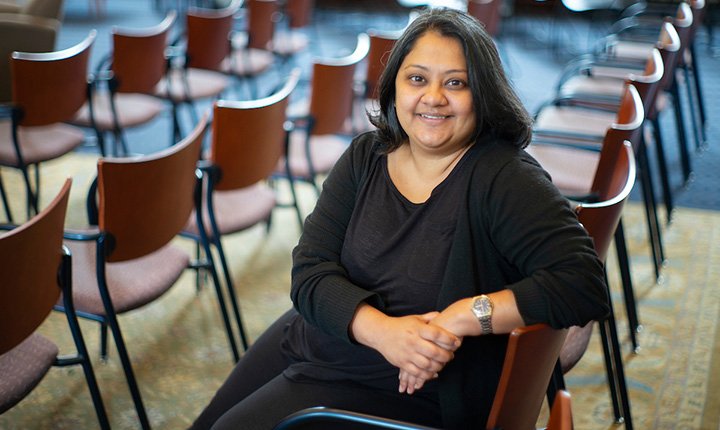Q&A with Cornell Visiting Professor of History Nafisa Essop Sheik

"Swarthmore takes the idea of community seriously," she says, "and I find that very compelling."
Gender historian Nafisa Essop Sheik’s primary connection to Swarthmore was visual: She had delighted in photos of the Crum Woods taken by Chair and Professor of History Tim Burke, a fellow expert on Africa with whom she shared a doctoral adviser. Beyond that, she admired the College’s academics and its place in the higher education landscape.
“I think Swarthmore has a great history, and that liberal arts institutions in the U.S. are a unique form of institution, representing a kind of learning that a lot of places can aspire to today,” says Essop Sheik.
So when the Department of History offered Essop Sheik this year’s Cornell Visiting Professorship, she pounced.
“I was very excited by the thought of becoming a part of the College,” she says.
Most recently a senior lecturer in history at the University of Johannesburg, Essop Sheik focuses her research primarily on law, marriage, and colonialism in Southeast Africa. These interests “tend to be informed by an abiding philosophical and empirical need to connect supposedly disparate or opposing historical questions and processes,” she says, “as well as an inexplicable attraction to the ironies of history.”
At Swarthmore, she is teaching “Engendering Difference: Sex, Gender, Race and the Making of Modern South Africa” this fall and a survey of South African history and writing in the spring.
Soon after settling into her office in Parrish Hall, Essop Sheik sat down to discuss early impressions of the College, the differences between Swarthmore and Johannesburg, her goals for the visiting professorship, and more.
How have things gone with your Swarthmore class?
I’m accustomed to lecture classes of 500 or 600, and the smaller, seminar-style classes here have been wonderful … and kind of intense. The students have almost always come well-prepared, ready and very willing to engage on the topics. It’s a very reading-heavy class, and my expectations are high, but they have more than answered the call. I am trying to frame the class in the context of the making of modern South Africa, a context with which none of the students are intimately familiar. I come with this kind of map of a particular space in history filled out, and worried about finding a way to present the material to keep the students interested and engaged. But they are so curious, and they work so hard. It’s their openness and curiosity that drive the class, and what make it so fun to do each time. I hope they’re enjoying it as much as I am.
In what other ways is Swarthmore different from Johannesburg?
It’s difficult to compare because undergrad teaching in Johannesburg, in this sort of post-apartheid transformation, has been more about access than anything else. It’s been about the numbers, a push to expand tertiary education in a determined way. So you get large lecture classes, as opposed to more engaged instruction here where you can measure outcomes more readily, not simply by testing. And the student success rate is much higher here because they tend to be better prepared right from the outset, compared to places where there aren’t as many resources marshaled to help them. So I would put the two institutions in different contexts in that sense, but also recognize some shared challenges for academia in general, globally.
Beyond that, Johannesburg is a really big, gritty city. So people don’t walk as much as they do here, for starters. It's a very viscerally different experience. It’s loud; it’s kind of intense. This is much more pastoral—sort of bucolic. A lovely change. I appreciate it very much.
What else are you hoping to accomplish while at Swarthmore?
Time is a very precious thing, and in addition to my teaching, I’ll have some time to work on my book manuscript [on gender and the making of difference in colonial Southeast Africa], as well as another project I am preparing on the gendered aspects of post-slavery indenture. So my aim is to finish up the year with as close to a completed manuscript as I can, to be published very soon by an academic press. Having the space to do that here, not to mention a fabulous library and all of these other resources, it’s a very comfortable opportunity I wouldn’t have had with my full-time teaching load back home. But I also find myself in a really interesting community. Swarthmore takes the idea of community seriously, and I find that very compelling, and I look forward to engaging with as many parts of the community as I can. I have already spoken with [staff from] the Lang Center for Civic & Social Responsibility and the Intercultural Center about opportunities to collaborate with people of different academic backgrounds. It’s very exciting.
What else would you like the College community to know?
I’m here with my husband, who is also an academic historian, and my 9-year-old son, who started third grade at Swarthmore–Rutledge School. And so far we’re having a ball. We even managed to find a cricket club in Warminster, where my son goes to get coached. So we’re all adapting and finding our way around. It’s just been lovely, and I do think it’s important to note how welcoming this community has been. People offer their resources and help in lots of ways, and it’s very nice to come to a place you’ve never been before and have those opportunities. So, thank you all!


